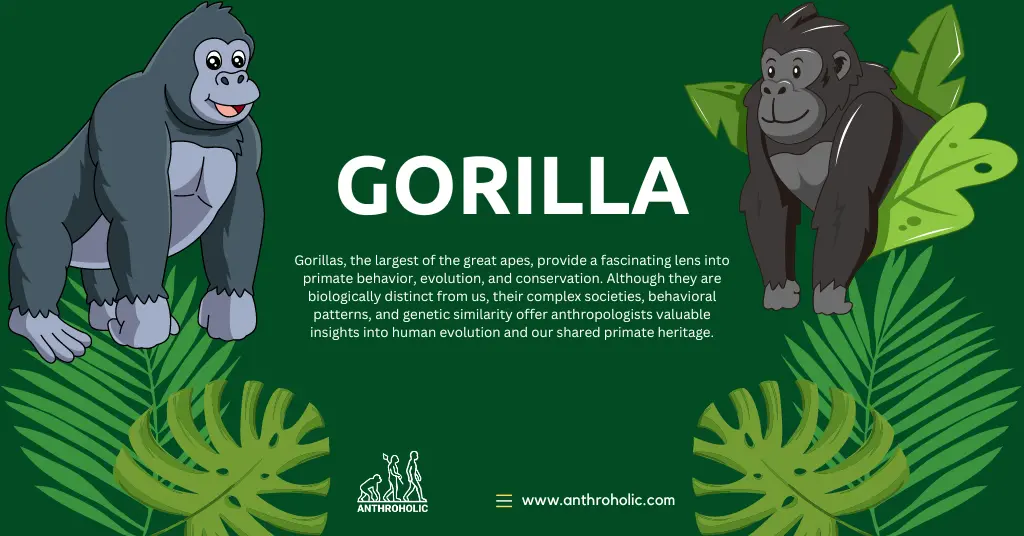AI Answer Evaluation Platform Live Now. Try Free Answer Evaluation Now
Gorilla
Gorillas, the largest of the great apes, provide a fascinating lens into primate behavior, evolution, and conservation. Although they are biologically distinct from us, their complex societies, behavioral patterns, and genetic similarity offer anthropologists valuable insights into human evolution and our shared primate heritage [1].

Evolutionary Connection
Origins and Genetic Similarities
Gorillas share a common ancestor with humans, diverging from a shared lineage between 7 and 6 million years ago. Genetic analyses reveal a 98.3% similarity between human and gorilla DNA, underscoring our close kinship [2].
| Species | Genetic Similarity with Humans |
|---|---|
| Chimpanzees | 98.7% |
| Gorillas | 98.3% |
| Orangutans | 96.9% |
Evolutionary Significance
The split between gorillas and our lineage serves as a crucial juncture in anthropological studies. Differences in size, dentition, and other morphological traits between humans and gorillas offer insights into selective pressures that may have shaped our evolution [3].
Gorilla Society and Behavior
Gorillas are largely gentle and highly social creatures, living in groups called troops. Their societal structures are complex and display behaviors that parallel human societies, like the use of tools and communication methods.
Social Structure
- Gorilla troops usually comprise one dominant male, several adult females, and their offspring [4].
- Young males, called “blackbacks,” may also be part of the troop until they establish their groups.
- The dominant male, or “silverback,” is the protector and leader of the group.
Communication and Tool Use
- Gorillas communicate using a wide array of vocalizations, facial expressions, and gestures.
- In terms of tool use, they have been observed using sticks to gauge the depth of water and stones to crack nuts.
Gorilla Subspecies and Geographic Distribution
Gorillas are classified into two species, each containing two subspecies: the Eastern gorilla (Gorilla beringei) and the Western gorilla (Gorilla gorilla). Each subspecies exhibits distinct differences in size, behavior, and geographic distribution.
| Species | Subspecies | Geographic Distribution |
|---|---|---|
| Eastern Gorilla | Mountain Gorilla (G. b. beringei) | Uganda, Rwanda, DRC |
| Grauer’s Gorilla (G. b. graueri) | Eastern DRC | |
| Western Gorilla | Western Lowland Gorilla (G. g. gorilla) | Central & West Africa |
| Cross River Gorilla (G. g. diehli) | Nigeria and Cameroon |
Gorilla Anatomy and Morphology
Gorillas are the largest of the great apes, with males significantly larger than females. They are quadrupedal and possess robust bodies designed for knuckle-walking. Their large arm span, heavy musculature, and prominent sagittal crest (in males) are among their distinguishing features.
Physical Characteristics
- Adult male gorillas can weigh up to 440 pounds and stand about 5.6 feet tall when erect.
- Females are generally half the size of males.
- Gorillas have a gestation period similar to humans, approximately 8.5 months, and typically give birth to one offspring at a time.
Threats to Gorilla Survival and Conservation Efforts
Gorilla populations are under severe threat due to human activities. Key threats include habitat loss, hunting for bushmeat, and diseases such as Ebola. Illegal pet trade also poses a significant danger.
Conservation Strategies
Efforts to conserve gorilla populations typically involve a combination of strategies:
- Habitat Protection: This involves the establishment and enforcement of protected areas where gorilla populations can thrive.
- Anti-Poaching Efforts: Implementing strict laws and regulations against poaching and illegal trade of gorillas.
- Community Engagement: Engaging local communities in conservation efforts is crucial. This may include creating alternative livelihoods to reduce dependence on forest resources.
References
[1] Harcourt, A. H., & Stewart, K. J. (2007). Gorilla Society: Conflict, Compromise, and Cooperation Between the Sexes. University of Chicago Press. http://dx.doi.org/10.1093/icb/icn009
[2] Prado-Martinez, J., et al. (2013). Great ape genetic diversity and population history. Nature, 499, 471–475.
[3] McFarlin, S. C., et al. (2018). Early hominids evolved within non-analog ecosystems. PNAS, 115(46), 12450–12455.
[4] Watts, D. P. (1996). Comparative socio-ecology of gorillas. Great Ape Societies, 16–28.




